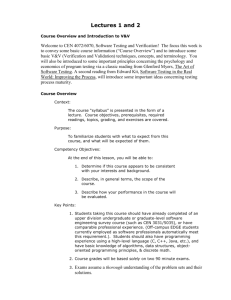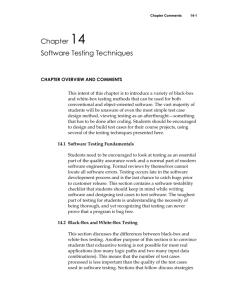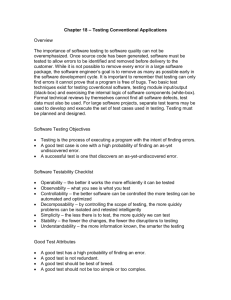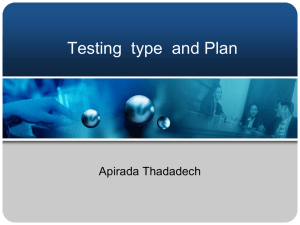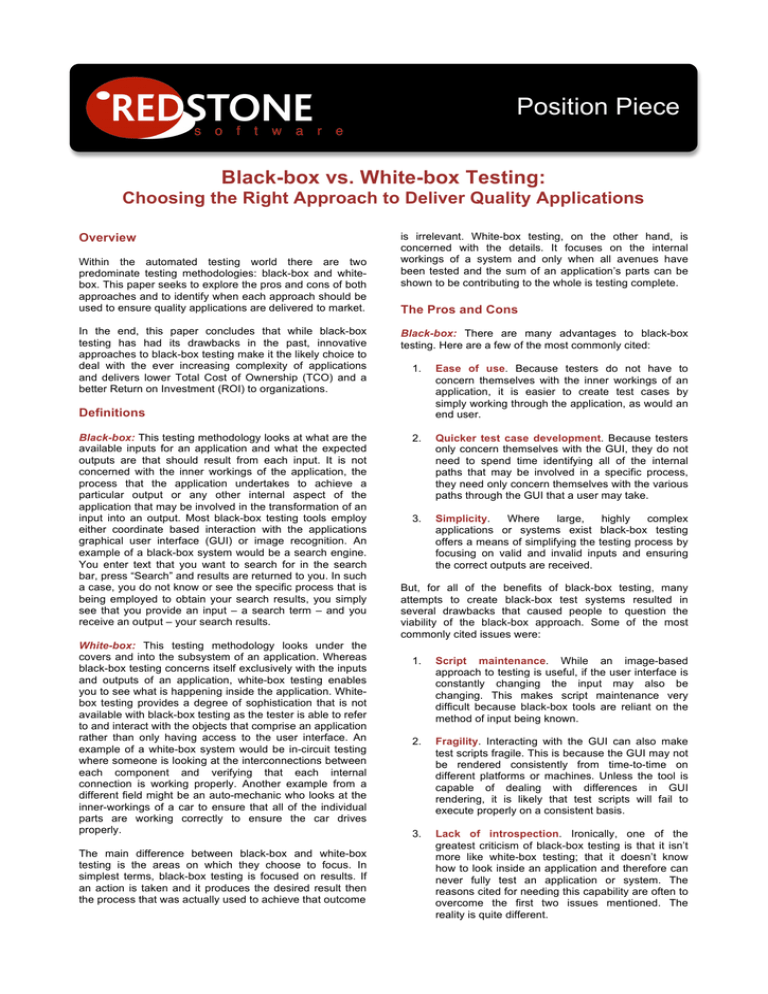
Position Piece
Black-box vs. White-box Testing:
Choosing the Right Approach to Deliver Quality Applications
Overview
Within the automated testing world there are two
predominate testing methodologies: black-box and whitebox. This paper seeks to explore the pros and cons of both
approaches and to identify when each approach should be
used to ensure quality applications are delivered to market.
In the end, this paper concludes that while black-box
testing has had its drawbacks in the past, innovative
approaches to black-box testing make it the likely choice to
deal with the ever increasing complexity of applications
and delivers lower Total Cost of Ownership (TCO) and a
better Return on Investment (ROI) to organizations.
is irrelevant. White-box testing, on the other hand, is
concerned with the details. It focuses on the internal
workings of a system and only when all avenues have
been tested and the sum of an application’s parts can be
shown to be contributing to the whole is testing complete.
The Pros and Cons
Black-box: There are many advantages to black-box
testing. Here are a few of the most commonly cited:
1.
Ease of use. Because testers do not have
concern themselves with the inner workings of
application, it is easier to create test cases
simply working through the application, as would
end user.
2.
Quicker test case development. Because testers
only concern themselves with the GUI, they do not
need to spend time identifying all of the internal
paths that may be involved in a specific process,
they need only concern themselves with the various
paths through the GUI that a user may take.
3.
Simplicity.
Where
large,
highly
complex
applications or systems exist black-box testing
offers a means of simplifying the testing process by
focusing on valid and invalid inputs and ensuring
the correct outputs are received.
Definitions
Black-box: This testing methodology looks at what are the
available inputs for an application and what the expected
outputs are that should result from each input. It is not
concerned with the inner workings of the application, the
process that the application undertakes to achieve a
particular output or any other internal aspect of the
application that may be involved in the transformation of an
input into an output. Most black-box testing tools employ
either coordinate based interaction with the applications
graphical user interface (GUI) or image recognition. An
example of a black-box system would be a search engine.
You enter text that you want to search for in the search
bar, press “Search” and results are returned to you. In such
a case, you do not know or see the specific process that is
being employed to obtain your search results, you simply
see that you provide an input – a search term – and you
receive an output – your search results.
White-box: This testing methodology looks under the
covers and into the subsystem of an application. Whereas
black-box testing concerns itself exclusively with the inputs
and outputs of an application, white-box testing enables
you to see what is happening inside the application. Whitebox testing provides a degree of sophistication that is not
available with black-box testing as the tester is able to refer
to and interact with the objects that comprise an application
rather than only having access to the user interface. An
example of a white-box system would be in-circuit testing
where someone is looking at the interconnections between
each component and verifying that each internal
connection is working properly. Another example from a
different field might be an auto-mechanic who looks at the
inner-workings of a car to ensure that all of the individual
parts are working correctly to ensure the car drives
properly.
The main difference between black-box and white-box
testing is the areas on which they choose to focus. In
simplest terms, black-box testing is focused on results. If
an action is taken and it produces the desired result then
the process that was actually used to achieve that outcome
to
an
by
an
But, for all of the benefits of black-box testing, many
attempts to create black-box test systems resulted in
several drawbacks that caused people to question the
viability of the black-box approach. Some of the most
commonly cited issues were:
1.
Script maintenance. While an image-based
approach to testing is useful, if the user interface is
constantly changing the input may also be
changing. This makes script maintenance very
difficult because black-box tools are reliant on the
method of input being known.
2.
Fragility. Interacting with the GUI can also make
test scripts fragile. This is because the GUI may not
be rendered consistently from time-to-time on
different platforms or machines. Unless the tool is
capable of dealing with differences in GUI
rendering, it is likely that test scripts will fail to
execute properly on a consistent basis.
3.
Lack of introspection. Ironically, one of the
greatest criticism of black-box testing is that it isn’t
more like white-box testing; that it doesn’t know
how to look inside an application and therefore can
never fully test an application or system. The
reasons cited for needing this capability are often to
overcome the first two issues mentioned. The
reality is quite different.
Position Piece
White-box: Like black-box testing, there are distinct
advantages to white-box testing. Here are a few of the
most commonly cited:
1.
2.
3.
Introspection. Introspection, or the ability to look
inside the application, means that testers can
identify objects programmatically. This is helpful
when the GUI is changing frequently or the GUI is
yet unknown as it allows testing to proceed. It also
can, in some situations, decrease the fragility of test
scripts provided the name of an object does not
change.
Stability. In reality, a by-product of introspection,
white-box testing can deliver greater stability and
reusability of test cases if the objects that comprise
an application never change.
Thoroughness. In situations where it is essential to
know that every path has been thoroughly tested,
that every possible internal interaction has been
examined, white-box testing is the only viable
method. As such, white-box testing offers testers
the ability to be more thorough in terms of how
much of an application they can test.
Despite these benefits, white-box testing has its
drawbacks. Some of the most commonly cited issues are:
1.
2.
3.
Complexity. Being able to see every constituent
part of an application means that a tester must have
detailed programmatic knowledge of the application
in order to work with it properly. This high-degree of
complexity requires a much more highly skilled
individual to develop test case.
Fragility. While introspection is supposed to
overcome the issue of application changes breaking
test scripts the reality is that often the names of
objects change during product development or new
paths through the application are added. The fact
that white-box testing requires test scripts to be
tightly tied to the underlying code of an application
means that changes to the code will often cause
white-box test scripts to break. This, then,
introduces a high degree of script maintenance into
the testing process.
Integration. For white-box testing to achieve the
degree of introspection required it must be tightly
integrated with the application being tested. This
creates a few problems. To be tightly integrated
with the code you must install the white-box tool on
the system on which the application is running. This
is okay, but where one wishes to eliminate the
possibility that the testing tool is what is causing
either a performance or operational problem, this
becomes impossible to resolve. Another issue that
arises is that of platform support. Due to the highly
integrated nature of white-box testing tools many do
not provide support for more than one platform,
usually Windows®. Where companies have
applications that run on other platforms, they either
need to use a different tool or resort to manual
testing.
Necessary vs. Nice to have
When approaching automated testing it is important to
understand what is necessary vs. what is nice to have.
Both testing methodologies have their merit. To determine
what approach should likely be used there are a few
questions that every company should ask:
1.
2.
3.
4.
5.
6.
7.
Who will use the application?
What parts of the application must be tested prior to
release and why?
What language will my application be written in?
When are significant changes to the UI likely to be
made and will the underlying code be affected?
Where is the application likely to be deployed?
How will the application be used?
Which platforms does the application need to
support?
Looking at each of these questions, some of the answers
that you might come up with are as follows:
1.
2.
3.
4.
5.
6.
7.
End users
Any part of the application that will be exposed to
the end user
Java using an Eclipse framework
Annually because our customers are always looking
for a new, fresh experience
On the web
Customers will login via the web and will enter
information through a series of screens
Web browsers like FireFox, IE, Opera and Safari
Based on the answers given one can make an educated
decision around the type of tool that should be used. In the
case of the application described above, a black-box tool
would likely be more effective as it is user-centric in its
approach, focuses on testing the interface rather than the
underlying code and a black-box tool is more likely to
support the multiple platforms required.
Reviewing the questions suggested above does expose a
more fundamental question about the nature of testing
itself. Why does anyone test? The question is not as silly
as it sounds and it reveals a lot about the long-term
viability of the two approaches being explored herein.
All companies test their applications prior to release
because their customers are intolerant of bugs. So, it is out
of a need to satisfy customers that testing is undertaken in
the first place. Given this, logic follows that to test in a
manner that reflects how a customer will use an application
should be a prerequisite. If this is true, then, only when
black-box testing has been applied to an application can
testing truly be said to have been completed.
This is an interesting argument and one that is unlikely to
sit well with white-box tool vendors. However, let’s review
what we know. Customers use GUIs, not code. They enter
information or interact with an application (the input) in
some fashion and wait to get something back (the output).
If the process works and they get an acceptable result,
they are happy. If not, they experience a problem. This is
identical to the approach employed by black-box testing
Position Piece
tools. As such, it would seem logical that a black-box tool
should be used. Now, that is not to say that white-box tools
to do not have their place, it is simply to say that they do
not provide sufficient test coverage on their own for an
organization to say that an application has been fully
tested.
White-box tool vendors would object strongly to the
previous statement. They would cite their introspective
capabilities as being superior to a black-box testing
approach. However, what a white-box vendor cannot
guarantee is that what occurs at the code-level will be
properly displayed on the UI. After all, the property of an
object might be set to “visible” but due to a fault in another
part of the application or even due to a problem outside of
the application, the object might not appear to the user. A
white-box tool would record the state change as having
passed because the “visible” property was successfully
updated. The fact that the user cannot actually see what
they are supposed to is largely overlooked. Even where
white-box vendors have introduced elements of imagerecognition to overcome the “visible” problem highlighted
above, white-box tools still tend to suffer from an inability to
deal with periodic differences in image rendering.
Although issues with white-box testing have been identified
above it should not be treated as a foregone conclusion
that black-box testing provide comprehensive application
testing coverage. Quite the contrary, what is hopefully
evident at this stage is that only when black-box and whitebox testing methodologies are combined is comprehensive
test coverage achieved. The reason for this is that both
methodologies address different aspects of application
testing itself. For black-box testing, the focus is on the user
experience whereas white-box testing focuses on the
internal and making sure that the application works as
efficiently as possible (or at least as designed). Therefore,
these two methodologies can be seen as complimentary
and for organizations that have the budget and time
available to take advantage of both, they should certainly
do so.
Black-box Testing: A Necessary Step
So far this position piece has highlight the pros and cons of
both black-box and white box approaches to test
Redstone Software is the leader in the development
of image-based automation, testing and remote
access software products. Redstone’s products are
designed to recreate and enhance the end-user
experience. Redstone’s flagship product, Eggplant™,
tests any system, validates any platform and
automates any process. Many of the world’s most
successful organizations and individuals rely on
Redstone Software to ensure delivery of the highest
quality products and best end-user experience
possible.
automation and discussed when each approach might be
most appropriate. In the last section, the idea of time and
money was introduced recognizing that organizations have
limited quantities of both. With those constraints in mind it
is prudent to revisit the discussion of which approach
provides the best test coverage for the lowest TCO and
greatest ROI.
Looking at the merits of both black-box and white-box
testing what seems to stand out is that black-box testing is
focused on the end user; that undertaking black-box
testing is the best way of ensuring that those parts of the
applications that will be exposed to the user work correctly.
Combined with the ease of use, quicker test case
development and simplicity, black-box testing represents a
lower initial cost than white-box testing and delivers ROI in
a shorter period of time.
Recognizing that to be the case, in the face of budgetary
and time constraints, black-box testing must be considered
a necessary steps in quality assurance process while
white-box test represents a nice to have.
Selecting a Black-box Testing Tool
When selecting a black-box testing tool there are several
things to look for:
1.
2.
3.
4.
What platforms does it support?
How resilient is it to differences in the way images
are rendered?
What facilities exist to aid in image recapture?
How does it identify images (by coordinates or
image recognition)?
By asking these questions and many more you will be able
to identify the black-box tool that is right for you. We would
recommend that you try Eggplant as it delivers all of the
benefits of black-box testing while overcoming nearly all of
the cited limitations.
Whichever tool you choose, hopefully you recognize the
importance of black-box testing in ensuring you are
delivering applications that have been tested as they will
be used and meet customer needs.
Further Information
For more information on how Redstone can help your
company visit:
www.redstonesoftware.com
or you can email at sales@redstonesoftware.com
US Tel: +1 952 873 6809
US Toll-Free: +1 800 891 3486
UK Tel: +44 1489 555500
© 2008 Redstone Software Inc. All rights reserved. Eggplant is a trademark of Redstone Software, Inc.
All other products and company names mentioned may be trademarks of their respective owners.

